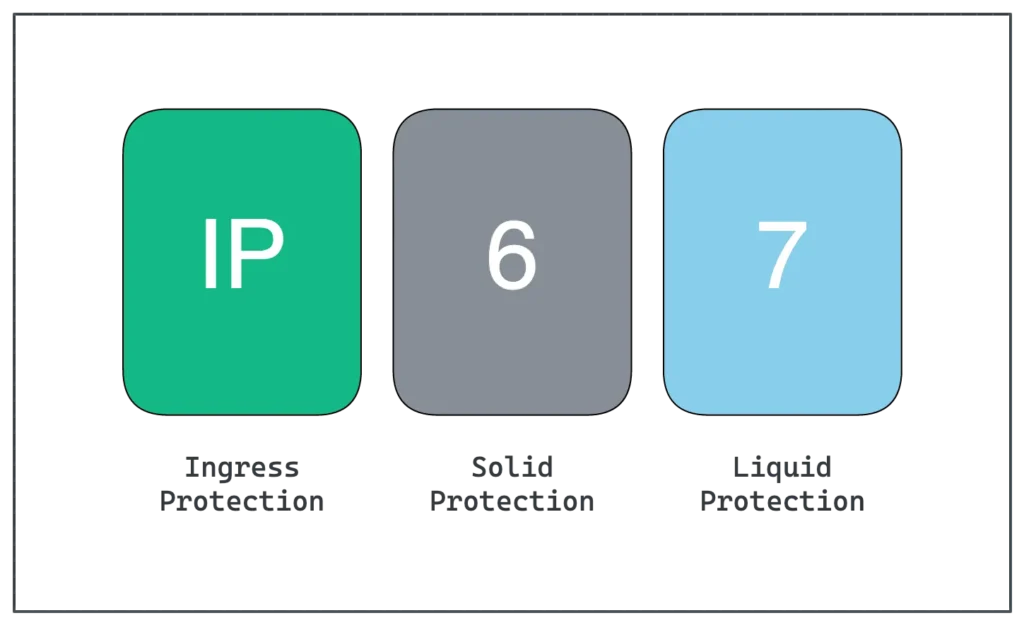If you have heard the term IP Rating but still frequently searching for keywords like ip57 vs ip67 OR ip67 vs ip68 then you are at the right place. This IP rating guide will help you to solidify your mental model of the IP Rating standard. I will also list out popular IR ratings to look out for in your next electronic gadget.
Table of Contents
What is IP Rating?

An IP (Ingress Protection) rating is a standard used to measure the level of protection provided by an electronic device against environmental factors such as dust and water. The rating is expressed in two digits, with the first digit indicating the level of protection against solid objects, and the second digit indicating the level of protection against water.
Understanding the IP rating of an electronic gadget is essential when choosing the right device for your needs. For example, if you plan to use your electronic gadget outdoors or in wet environments, you’ll want to choose a device with a higher IP rating.
Solid Objects Protection
The first digit ranges from 0 to 6, with 0 indicating no protection and 6 indicating protection against dust and other solid objects. For instance, an IP6X rating means the enclosure is completely dust-tight and offers total protection against contact. This rating is important for equipment that is used in dusty environments such as construction sites or factories.
Liquid Ingress Protection
The second digit ranges from 0 to 9, with 0 indicating no protection and 9 indicating protection against high-pressure and high-temperature water. For instance, an IPX9 rating means that the equipment can withstand high-pressure water from all angles, making it suitable for use in marine environments or during high-pressure cleaning.
The ratings for water ingress, such as IPX5, IPX6, and IPX7, are not cumulative beyond IPX6. This means that a device compliant with IPX7, which covers immersion in water, may not necessarily be compliant with IPX5 or IPX6, which covers exposure to water jets. If a device passes both tests, its compliance is indicated by listing both ratings separated by a slash, such as IPX5/IPX7.
IP Rating Table
| Solid Objects Protection | Level | Liquid Ingress Protection |
|---|---|---|
| X means there’s no data available. | X | X means there’s no data available. |
| Protection against solid objects larger than 50mm, such as hands or large tools. | 1 | Protection against dripping water falling on the device from a vertical angle. |
| Protection against solid objects larger than 12.5mm, such as fingers or small tools. | 2 | Protection against dripping water falling on the device when tilted at an angle of up to 15 degrees. |
| Protection against solid objects larger than 2.5mm, such as tools and thick wires. | 3 | Protection against spraying water coming from any direction. |
| Protection against solid objects larger than 1mm, such as small tools, wires, and particles. | 4 | Protection against splashing water coming from any direction. |
| Dust protected – Protection against dust that may harm the device’s operation. | 5 | Protection against water jets coming from any direction. |
| Dust-tight – Protection against dust and other small particles. | 6 | Protection against powerful water jets coming from any direction. |
| – | 7 | Protection against the device’s immersion in water for a short period, usually up to 30 minutes. |
| – | 8 | Protection against continuous immersion in water beyond the limits of IPX7 rating. |
| – | 9K | Protection against high-pressure and high-temperature water jets from different angles for up to 3 minutes. |
Common IP Ratings for Electronic Gadgets
When buying electronic gadgets such as earbuds, mobile phones, headphones, or smartwatches, it’s important to consider their IP (Ingress Protection) ratings to ensure that they are protected against dust, water, and other foreign objects. Here are some common IP ratings to look out for:
- IP54: Protection against dust and splashing water.
- IP67: Protection against dust and temporary immersion in water.
- IP68: Protection against dust and continuous immersion in water.
Keep in mind that the higher the IP rating, the more protection the device provides against environmental factors.
Water-resistant doesn’t mean Waterproof
It is important to note that while IP rating can indicate a device’s level of protection against water and dust, water-resistant does not mean waterproof. Even devices with high IP ratings may not be able to withstand complete submersion in water or prolonged exposure to water under certain conditions. It’s important to use electronic gadgets carefully and follow some tips to prevent water damage, such as:
- Avoid exposing devices to water unnecessarily, especially for extended periods of time.
- Keep devices away from high humidity and moisture, such as in bathrooms or near swimming pools.
- Use protective cases or covers that are designed to provide additional water resistance.
- Avoid using devices in extreme temperatures or environments, such as during heavy rain or snow.
- In case of accidental water exposure, turn off the device immediately and dry it thoroughly before attempting to use it again.
Conclusion
Understanding IP ratings is essential when choosing the right electronic gadget for your needs. I hope with this knowledge, you can confidently purchase electronic gadgets that will perform well in different environments and conditions.
Check out this funny summary video on IP Rating by GORE.